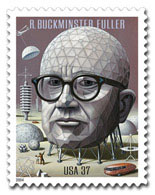A few days back, David posted a link about the Dymaxion Car, Bucky Fuller’s ill-fated attempt to inject sanity in to Detroit. In 1933. Maybe I’m just being me, but I think David was trying to taunt me in to posting. I did, after all, pick a related title for my blog.

I should say that well before I read people like Amory Lovins, Buckminster Fuller had a profound effect on my thinking as an environmentalist and as a person generally. Some of his ideas were just downright wacky — cities inside glass bubbles so large they float like hot air balloons, for starters — but when it comes to sustainability, technological progress, and the relationship of humans to the Earth, I am a devoted Fullerite. (Not to be confused with Fullerenes.)
Fuller’s key insights — which are now commonplace, but weren’t necessarily when he started writing — centered on what would now be called end-use efficiency, or what Fuller called variously “doing-more-with-lessing” or “ephemeralization.”
The Dymaxion car was a clear example of this philosophy, but so was his Dymaxion house. Both showed the benefits of efficiency and system design. Both died unlamented deaths. But both ideas — high-efficiency cars, and zero-energy (prefab) homes — are rapidly coming back in to the main.
Most importantly (and this really is crucial to my worldview), Fuller saw competition — selfish, violent, zero-sum games — as totally obsolete in the modern world.
Rather, Fuller believed (and, his acolytes would say, proved) that cooperation is not only morally superior, but pragmatically necessary. The forces of division, in a world with nuclear power, would only hurt us in the end, while the forces of unity would save us all. Or, as he put it:
Whether it is to be Utopia or Oblivion will be a touch-and-go relay race right up to the final moment.
When I am in my foulest moods and convinced the world is doomed, that sentence gives me more serenity than anything Godly ever has.


